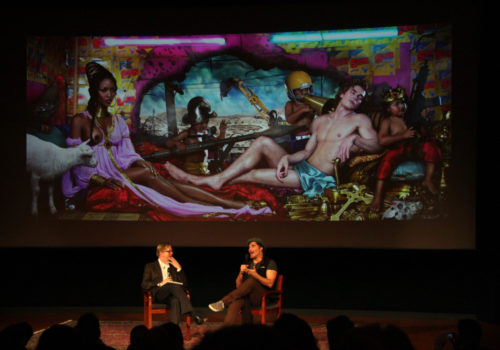The annual National Geographic seminar took place last week in Washington. Jean-François Leroy, director of the Visa pour l’Image Festival, was there:
“It was a beautiful Thursday morning. In the National Geographic lobby, the crowding meant it would be a brilliant new convention.
After National Geographic Photo Director Kurt Mutchler’s welcome speech, activities began with a screening of Paolo Pellegrin’s preceded by his homage to France 2 senior reporter Gilles Jacquier, recently killed while on assignment in Homs, Syria. The editing was a bit choppy, but the film provided spectators with a glimpse of the astounding work of the photographer in the last ten years.
A moment of relaxation with the next subject by Robin Schwartz who presented her work with her daughter Amélia about animals. Dogs and cats, of course, but also giraffes, elephants, tigers and kangaroos.
Many of us were a bit disappointed by Cirenaica Moreira’s work. The pictures were interesting, but the comments were laborious and too long. 45 minutes of comments and not enough pictures, which kept us yearning for more at lunch break.
Editor in Chief Chris Johns welcomed us back after the break. He greeted the many photographers and former editors in the room, with a warm acknowledgement to Kent Kobersteen, absent for health reasons but whose latest test results, we learned, were encouraging. Then he gave a long homage to the late Susan Smith, one of photography’s pillars for so many years, who passed away last July.
Kitra Cahana presented her work on teenagers ,that was one of the year’s story most recognized and most approved by National Geographic reader.
She was followed by Anthony Suau who spoke of the evolution of « Facing Change », that can already be compared to Carl Mydans and Dorothea Lange’s famous FSA… Would you believe it? In any case, the project is taking shape, advancing, and we can follow and encourage it here: http://facingchange.org/ Look at the participating photographers… Very interesting isn’t it?
Gillian Laub’s work on racism in small southern American cities and the changes her work provoked – notably after being featured in the New York Times Magazine – is just incredible. Sometimes but rarely photography can change the world.
The day’s final presentation was eagerly awaited. David Lachapelle! Everyone was expecting slightly pretentious extravagance. We were going to show him, the King of Photoshop, what a “real” photo was. Every one was nicely surprised. Lachapelle was very much himself. Humble, funny, immensely cultivated, he shocked everyone! At the end of his interview, he showed us the making of his Pieta. When spectators realized there was NO photo manipulation involved, he triumphed!”
Jean-François Leroy
















